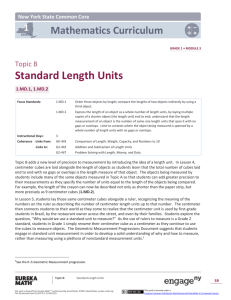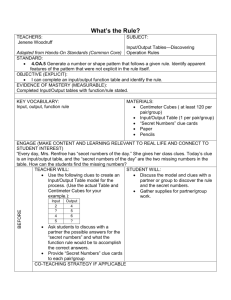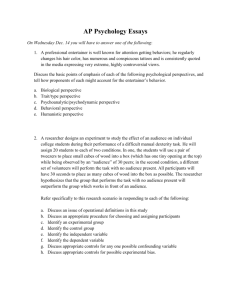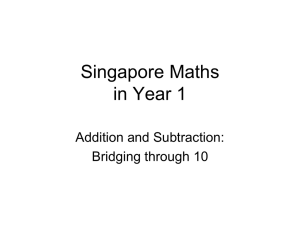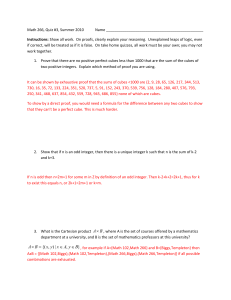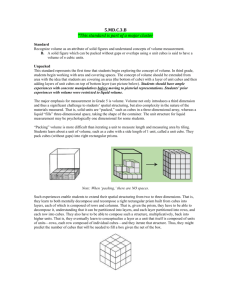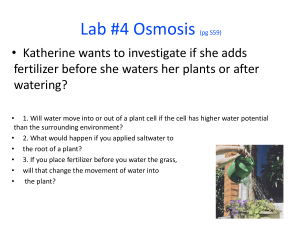Module 3
advertisement
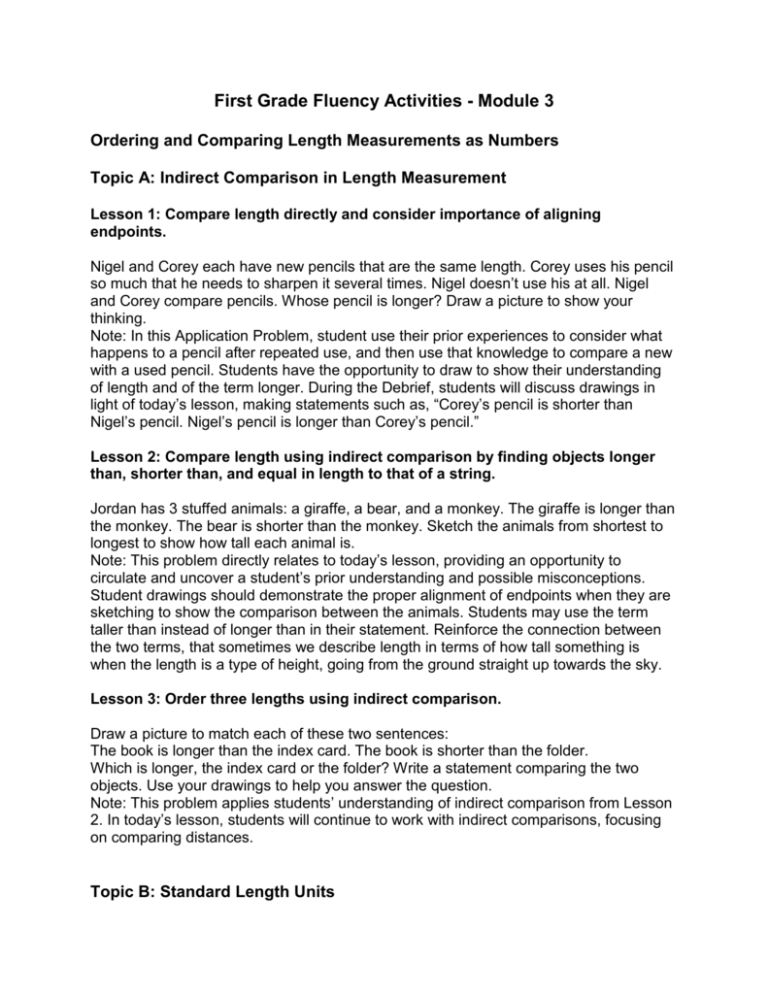
First Grade Fluency Activities - Module 3 Ordering and Comparing Length Measurements as Numbers Topic A: Indirect Comparison in Length Measurement Lesson 1: Compare length directly and consider importance of aligning endpoints. Nigel and Corey each have new pencils that are the same length. Corey uses his pencil so much that he needs to sharpen it several times. Nigel doesn’t use his at all. Nigel and Corey compare pencils. Whose pencil is longer? Draw a picture to show your thinking. Note: In this Application Problem, student use their prior experiences to consider what happens to a pencil after repeated use, and then use that knowledge to compare a new with a used pencil. Students have the opportunity to draw to show their understanding of length and of the term longer. During the Debrief, students will discuss drawings in light of today’s lesson, making statements such as, “Corey’s pencil is shorter than Nigel’s pencil. Nigel’s pencil is longer than Corey’s pencil.” Lesson 2: Compare length using indirect comparison by finding objects longer than, shorter than, and equal in length to that of a string. Jordan has 3 stuffed animals: a giraffe, a bear, and a monkey. The giraffe is longer than the monkey. The bear is shorter than the monkey. Sketch the animals from shortest to longest to show how tall each animal is. Note: This problem directly relates to today’s lesson, providing an opportunity to circulate and uncover a student’s prior understanding and possible misconceptions. Student drawings should demonstrate the proper alignment of endpoints when they are sketching to show the comparison between the animals. Students may use the term taller than instead of longer than in their statement. Reinforce the connection between the two terms, that sometimes we describe length in terms of how tall something is when the length is a type of height, going from the ground straight up towards the sky. Lesson 3: Order three lengths using indirect comparison. Draw a picture to match each of these two sentences: The book is longer than the index card. The book is shorter than the folder. Which is longer, the index card or the folder? Write a statement comparing the two objects. Use your drawings to help you answer the question. Note: This problem applies students’ understanding of indirect comparison from Lesson 2. In today’s lesson, students will continue to work with indirect comparisons, focusing on comparing distances. Topic B: Standard Length Units Lesson 4: Express the length of an object using centimeter cubes as length units to measure with no gaps or overlaps. Joe ran a string from his room to his sister’s room to measure the distance between them. When he tried to use the same string to measure the distance from his room to his brother’s room, the string didn’t reach! Which room was closer to Joe’s room, his sister’s or his brother’s? Note: This problem directly applies students’ learning from Lesson 3, as students use indirect comparison to compare distances. For many students, such problems can be challenging to visualize on the first read. After reading, encourage students to draw a picture to show each part before answering the question. Reread the problem, pausing long enough for students to draw a picture of the comparison of the string and Joe’s sister’s room before moving on to read the next sentence. Pictures may vary in many ways. As long as the picture demonstrates that Joe’s sister’s room is closer than Joe’s brother’s room, any formation can provide an appropriate representation. Lesson 5: Rename and measure with centimeter cubes, using their standard unit name of centimeters. Amy used centimeter cubes to measure the length of her book. She used 8 yellow centimeter cubes and 4 red centimeter cubes. How many centimeter cubes long was her book? Remind students to use the RDW process. After reading (or listening to) the problem, they must be sure to draw, write a number sentence, and write a statement that answers the question. Note: This problem uses the context of measurement while enabling students to review their processes for adding single digits whose sum is a teen number. Take note of the strategies students are using independently. Are they making ten first? Are they counting on? Are they counting all after drawing the picture? During the Debrief, students will have the opportunity to connect, or rename, the unit length of centimeter cube to the more common unit length of centimeter. Lesson 6: Order, measure, and compare the length of objects before and after measuring with centimeter cubes, solving compare with difference unknown word problems. Julia’s lollipop is 15 centimeters long. She measured the lollipop with 9 red centimeter cubes and some blue centimeter cubes. How many blue centimeter cubes did she use? Remember to use the RDW process. Note: This problem enables students to continue working with take apart with difference unknown problem types within the context of measurement. During the Debrief, students will compare the length of Julia’s lollipop with another item from the lesson to determine how much longer the lollipop is compared to that item. Topic C: Non-Standard and Standard Length Units Lesson 7: Measure the same objects from Topic B with different non- standard units simultaneously to see the need to measure with a consistent unit. When Corey measures his new pencil, he uses 19 centimeter cubes. After he sharpens it, he needs 4 fewer centimeter cubes. How long is Corey’s pencil after he sharpens it? Use centimeter cubes to solve the problem. Write a number sentence and a statement to answer the question. Note: As students build measurements with centimeter cubes, they continue to connect their experiences of addition and subtraction with concrete problem situations. As students work, encourage them to talk through the problem sentence by sentence, placing the centimeter cubes in front of them to build the story. During the Debrief, connect the students’ concrete experience with the problem type or computation. Lesson 8: Understand the need to use the same units when comparing measurements with others. Each crayon is 9 centimeter cubes long. The paintbrush is the same length as 2 crayons. How many centimeter cubes long is the paintbrush? Use centimeter cubes to solve the problem. Write a number sentence and a statement to answer the question. Note: Students continue to use concrete materials to consider problem situations. Continue to encourage students to build each part of the story, using the cubes to think through what they know and to identify what they do not yet know. During the Debrief, students can demonstrate their strategies for solving the problem. The example above right shows several ways in which students may solve this Application Problem. Some students may simply align the cubes and solve without drawing. Lesson 9: Answer compare with difference unknown problems about lengths of two different objects measured in centimeters. Corey buys a super-cool, extra-long crayon that is 14 centimeters long. His regular crayon is 9 centimeters long. Use centimeter cubes to decide how much longer Corey’s new crayon is than his regular crayon. Write a statement to answer the question. Write a number sentence to show what you did. Note: This problem continues to provide students with opportunities to concretely build various lengths with centimeter cubes. As students work towards solving compare with difference unknown problem types, experiences with concrete objects like centimeter cubes can strengthen understanding. Students will be exploring the comparison of centimeter cubes during today’s lesson. As students work, notice how they are solving and use your analysis during the Concept Development. Topic D: Data Interpretation Lesson 10: Collect, sort, and organize data, then ask and answer questions about the number of data points. There were 14 items on the table to measure. I already measured 5 of them. How many more items are there to measure? Note: The use of the word measure in this problem raises a level of complexity as students may expect to use a measuring tool to solve. This problem encourages students to consider the context of the whole problem rather than focusing solely on key words. Lesson 11: Collect, sort, and organize data, then ask and answer questions about the number of data points. Larry asked his friends whether dogs or cats are smarter. Nine of his friends think dogs are smarter and 6 think cats are smarter. Make a table to show Larry’s data collection. How many friends did he ask? Note: This Application Problem reviews data collection (G1– M3–L10). Some students may show their work with simple shapes such as lines or circles, while others may experiment with tally marks. Lesson 12: Ask and answer varied word problem types about a data set with three categories. Kingston’s class took a trip to the zoo. He collected data about his favorite African animals. He saw 2 lions, 11 gorillas, and 7 zebras. What does his table look like? Write one question your classmate can answer by looking at the table. Note: Students may use any of the methods to collect data from the previous lessons. As they are working, circulate and notice how students are representing the data. Encourage them to line up their shapes and focus on organization. Remind students that they need to use the same symbol to represent the information throughout their table. Representations should make counting and comparing data easy. During the Debrief, the students will share and answer their partners’ questions. Lesson 13: Ask and answer varied word problem types about a data set with three categories. Zoe wanted to make a friendship necklace for her closest friends. Make a graph to show the two colors of beads she used. She used 8 green beads for Lily, 4 purple beads for Jamilah, and 12 green beads for Sage. How many green beads did she use? Note: As students finish, ask additional questions to help them interpret the data, focusing on Grade 1 problem types. How many more purple beads would need to be used to have the same amount as the green beads? How many fewer beads does Lily have than Sage? If Lily added 3 beads to her necklace, how many more beads would she need to have the same amount as Sage?
